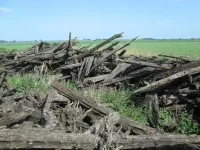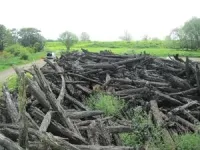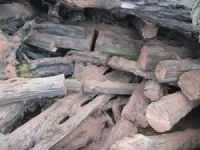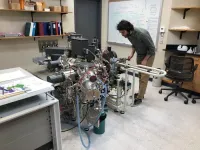(Press-News.org) The Fens of eastern England, a low-lying, extremely flat landscape dominated by agricultural fields, was once a vast woodland filled with huge yew trees, according to new research.
Scientists from the University of Cambridge studied hundreds of tree trunks, dug up by Fenland farmers while ploughing their fields. The team found that most of the ancient wood came from yew trees that populated the area between four and five thousand years ago.
These trees, which are a nuisance when they jam farming equipment during ploughing, contain a treasure trove of perfectly preserved information about what the Fens looked like thousands of years ago.
The Fen yew woodlands suddenly died about 4,200 years ago, when the trees fell into peat and were preserved until today. The researchers hypothesise that a rapid sea level rise in the North Sea flooded the area with salt water, causing the vast woodlands to disappear.
The climate and environmental information these trees contain could be a valuable clue in determining whether this climate event could be related to other events that happened elsewhere in the world at the same time, including a megadrought in the Middle East that may have been a factor in the collapse of ancient Egypt’s Old Kingdom. Their results are reported in the journal Quaternary Science Reviews.
Yew (Taxus baccata) trees are one of the longest-lived species in Europe, and can reach up to 20 metres in height. While these trees are fairly common in Cambridge College gardens and churchyards across southern England, they are absent in the Fens, the low-lying marshy region of eastern England. Much of the Fens was a wetland until it was drained between the 17th and 19th centuries using artificial drainage and flood protection. Today, the area is some of the most productive farmland in the UK, thanks to its rich peat soil.
While the area is great for farming and does have its own charms, few people would describe the Fens as spectacular: for the most part, the area is extremely flat and dominated by fields of potatoes, sugar beet, wheat and other crops. But five thousand years ago, the area was a huge forest.
“A common annoyance for Fenland farmers is getting their equipment caught on big pieces of wood buried in the soil, which can often happen when planting potatoes, since they are planted a little deeper than other crops,” said lead author Tatiana Bebchuk, a PhD student from Cambridge’s Department of Geography. “This wood is often pulled up and piled at the edge of fields: it’s a pretty common sight to see these huge piles of logs when driving through the area.”
For farmers, these logs are a nuisance. But for Bebchuk and her colleagues, they are buried treasure. The Cambridge team approached several Fenland farmers and took samples of hundreds of logs that had been dug up and discarded, to find out what secrets they might hold.
“I remember when I first saw this enormous pile of abandoned trees, it was incredible just how many there were,” said Bebchuk. “But when we got them back to lab, we were even more surprised: these trees were so well-preserved, it looked as if they were cut down just yesterday.”
To put current anthropogenic climate change in a long-term context of natural variability, scientists need accurate evidence from the past, and trees are some of the best recorders of past conditions: their annual growth rings contain information about temperature and hydroclimate for every growing season they witnessed. “But the further back in time we go, the less reliable evidence we have, since very old trees and well-preserved wood materials are extremely rare,” said Professor Ulf Büntgen, the senior author of the study.
However, analysis by the Cambridge Tree-Ring Unit (TRU) showed that the yew trees dug up from Fenland fields were very old indeed: some of these ancient trees were 400 years old when they died. The new find provides unique climate information for over a millennium from around 5,200 years ago until about 4,200 years ago, when much of the Fens was a woodland of yew and oak: completely different than it looks today.
“Finding these very old trees in the Fens is completely unexpected – it would be like turning a corner in rural Cambridgeshire and seeing an Egyptian pyramid – you just wouldn’t expect it,” said Bebchuk. “It’s the same with nature – wood rots and decomposes easily, so you just don’t expect a tree that died five or four thousand years ago to last so long.”
Given that most of the Fens are barely above sea level, about 4,200 years ago, a sudden rise in sea level most likely killed the Fen woodlands. The period that the Fen woodlands died coincided with major climatic changes elsewhere in the world: at roughly the same time, a megadrought in China and the Middle East was a possible trigger of the collapse of several civilisations, including Egypt’s Old Kingdom and the Akkadian Empire in Mesopotamia.
“We want to know if there is any link between these climatic events,” said Bebchuk. “Are the megadroughts in Asia and the Middle East possibly related to the rapid sea level rise in northern Europe? Was this a global climate event, or was it a series of unrelated regional changes? We don’t yet know what could have caused these climate events, but these trees could be an important part of solving this detective story.”
“This is such a unique climate and environmental archive that will provide lots of opportunities for future studies, and it’s right from Cambridge’s own backyard,” said Büntgen. “We often travel all over the world to collect ice cores or ancient trees, but it’s really special to find such a unique archive so close to the office.”
END
The Fens of eastern England once held vast woodlands, study finds
2023-11-24
ELSE PRESS RELEASES FROM THIS DATE:
Premature death of autistic people in the UK investigated for the first time
2023-11-24
A new study led by UCL researchers confirms that autistic people experience a reduced life expectancy, however the number of years of life lost may not be as high as previously claimed.
The research, published in The Lancet Regional Health – Europe, is the first to estimate the life expectancy and years of life lost by autistic people living in the UK.
The team used anonymised data from GP practices throughout the UK to study people who received an autism diagnosis between 1989 to 2019. They ...
How do plants determine where the light is coming from ?
2023-11-23
Plants have no visual organs, so how do they know where light comes from? In an original study combining expertise in biology and engineering, the team led by Prof Christian Fankhauser at UNIL, in collaboration with colleagues at EPFL, has uncovered that a light-sensitive plant tissue uses the optical properties of the interface between air and water to generate a light gradient that is 'visible' to the plant. These results have been published in the journal Science.
The majority of living organisms (micro-organisms, plants and animals) have the ability to determine the origin of a light source, even in the absence of a sight organ comparable to the eye. This information is invaluable ...
Study provides fresh insights into antibiotic resistance, fitness landscapes
2023-11-23
E. coli bacteria may be far more capable at evolving antibiotic resistance than scientists previously thought, according to a new study published in Science on November 24.
Led by SFI External Professor Andreas Wagner, the researchers experimentally mapped more than 260,000 possible mutations of an E. coli protein that is essential for the bacteria’s survival when exposed to the antibiotic trimethoprim.
Over the course of thousands of highly realistic digital simulations, the researchers then found that 75% of all possible evolutionary paths of the E. coli protein ultimately ...
Separating out signals recorded at the seafloor
2023-11-23
Blame it on plate tectonics. The deep ocean is never preserved, but instead is lost to time as the seafloor is subducted. Geologists are mostly left with shallower rocks from closer to the shoreline to inform their studies of Earth history.
“We have only a good record of the deep ocean for the last ~180 million years,” said David Fike, the Glassberg/Greensfelder Distinguished University Professor of Earth, Environmental, and Planetary Sciences in Arts & Sciences at Washington University in St. Louis. “Everything else is just shallow-water deposits. So it’s really important to understand the bias that might be present when we look ...
Dolomite crystals require cycles of saturation conditions to grow
2023-11-23
Addressing the long-standing “dolomite problem,” an oddity that has vexed scientists for nearly 200 years, researchers report that dolomite crystals require cycling of saturation conditions to grow. The findings provide new insights into how dolomite is formed and why modern dolomite is primarily found in natural environments with pH or salinity fluctuations. Dolomite – a calcium magnesium carbonate – is one of the major minerals in carbonate rocks, accounting for nearly 30% of the sedimentary carbonate minerality in Earth’s crust. However, despite its geological abundance, dolomite does not readily grow under laboratory conditions, ...
FLSHclust, a new algorithm, reveals rare and previously unknown CRISPR-Cas systems
2023-11-23
Using a new algorithm called FLSHclust (“flash clust”), researchers have discovered 188 rare and previously unknown CRISPR-linked gene modules – including a novel type VII CRISPR-Cas system – among billions of protein sequences. The approach and its findings provide novel opportunities for harnessing CRISPR systems and understanding the vast functional diversity of microbial proteins. CRISPR systems have been leveraged to develop a growing suite of novel biomolecular approaches, including CRISPR/Cas-mediated genome editing. The discovery ...
Extremely energetic cosmic ray detected, but with no obvious source
2023-11-23
An extremely energetic cosmic ray – an extragalactic particle with an energy exceeding ~240 exa-electron volts (EeV) – has been detected by the Telescope Array experiment’s surface detector, researchers report. However, according to the findings, its arrival direction shows no obvious source. Ultrahigh-energy cosmic rays (UHECRs) are subatomic charged particles from space with energies greater than 1 EeV – roughly a million times as high as the energy reached by human-made particle accelerators. Although low-energy cosmic rays primarily emanate from the sun, the origins of rarer UHECRs are thought to be related to the most energetic phenomena in the Universe, ...
Telescope Array detects second highest-energy cosmic ray ever
2023-11-23
In 1991, the University of Utah Fly’s Eye experiment detected the highest-energy cosmic ray ever observed. Later dubbed the Oh-My-God particle, the cosmic ray’s energy shocked astrophysicists. Nothing in our galaxy had the power to produce it, and the particle had more energy than was theoretically possible for cosmic rays traveling to Earth from other galaxies. Simply put, the particle should not exist.
The Telescope Array has since observed more than 30 ultra-high-energy cosmic rays, though none approaching the Oh-My-God-level energy. No observations have yet revealed ...
'Dolomite Problem': 200-year-old geology mystery resolved
2023-11-23
Images // Video
ANN ARBOR—For 200 years, scientists have failed to grow a common mineral in the laboratory under the conditions believed to have formed it naturally. Now, a team of researchers from the University of Michigan and Hokkaido University in Sapporo, Japan have finally pulled it off, thanks to a new theory developed from atomic simulations.
Their success resolves a long-standing geology mystery called the "Dolomite Problem." Dolomite—a key mineral in the Dolomite mountains in Italy, Niagara Falls, the White Cliffs of Dover and Utah's Hoodoos—is very abundant in rocks older than 100 million years, but nearly absent in younger ...
AI recognizes the tempo and stages of embryonic development
2023-11-23
Animal embryos go through a series of characteristic developmental stages on their journey from a fertilized egg cell to a functional organism. This biological process is largely genetically controlled and follows a similar pattern across different animal species. Yet, there are differences in the details – between individual species and even among embryos of the same species. For example, the tempo at which individual embryonic stages are passed through can vary. Such variations in embryonic development are considered an important driver of evolution, as they can lead to new characteristics, thus promoting evolutionary adaptations and biodiversity.
Studying the embryonic ...




